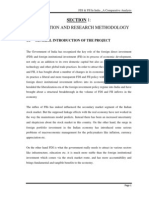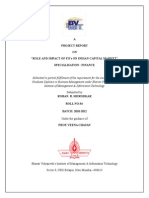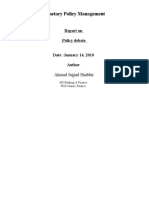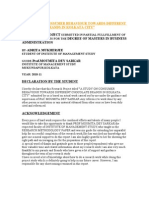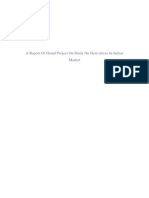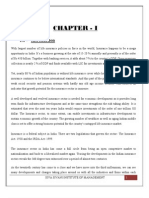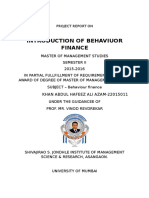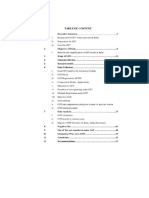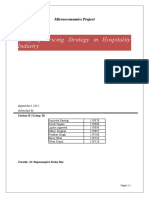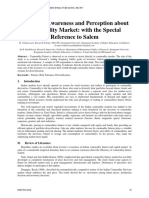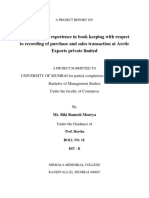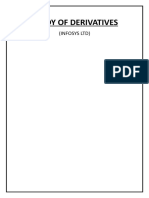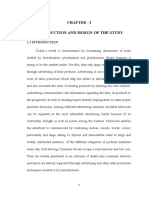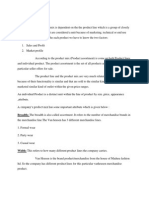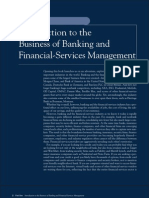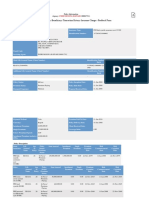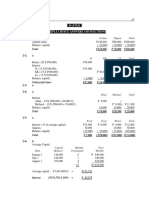Inflation Impact On Indian Economy Agriculture
Inflation Impact On Indian Economy Agriculture
Uploaded by
Avirup ChakrabortyCopyright:
Available Formats
Inflation Impact On Indian Economy Agriculture
Inflation Impact On Indian Economy Agriculture
Uploaded by
Avirup ChakrabortyOriginal Description:
Original Title
Copyright
Available Formats
Share this document
Did you find this document useful?
Is this content inappropriate?
Copyright:
Available Formats
Inflation Impact On Indian Economy Agriculture
Inflation Impact On Indian Economy Agriculture
Uploaded by
Avirup ChakrabortyCopyright:
Available Formats
International Journal of Scientific & Engineering Research, Volume 4, Issue 7, July-2013
ISSN 2229-5518
1459
Inflation Impact on Indian Economy &
Agriculture
Savneet Kaur
Abstract Inflation is the rise in the prices of goods and services and affects all the major sectors in an economy. Inflation also reflects
erosion in the purchasing power of money a loss of real value in the internal medium of exchange and unit of account in the economy. In
a country like Indian where a majority of population is working in agriculture sector, the effect of inflation increases manifold. This paper
aims to put light on the impact of inflation on Indian agriculture and then give some suggestions for the improvement of the economy.
Index Terms Food inflation, Inflation, Indian economy, Indian agriculture, monetary policy, macro & micro economics, RBI policy.
An Introduction:
Inflation is a rise in the general level of prices of goods and
services in an economy over a period of time. When the
general price level rises, each unit of currency buys fewer
goods and services. Consequently, inflation also reflects
erosion in the purchasing power of money a loss of real
value in the internal medium of exchange and unit of
account in the economy.
On March 19, 2010, the Reserve Bank of India raised its
benchmark reverse repurchase rate to 3.5% percent, after
this rate touched record lows of 3.25%. The repurchase rate
was raised to 5% from 4.75% as well, in an attempt to curb
Indian inflation.
IJSER
The Indian method for calculating inflation, the Wholesale
Price Index, is different from the rest of world. Each week,
the wholesale price of a set of 435 goods is calculated by the
Indian government. Since these are wholesale prices, the
actual prices paid by consumers are far higher.
In times of rising inflation, this also means that the cost of
living increases are much higher for the populace. Due to
increasing prices, people have to spend more to maintain
the standard of living. So, inflation is eating up the savings
of an average man.
With most of Indias vast population living close to or
below the poverty line, inflation acts as a Poor Mans Tax.
This effect is amplified when food prices rise, since food
represents more than half of the expenditure of this group.
Recent History and Present Status:
Indias 2009-10 Economic Survey Report suggested a high
double-digit increase in food inflation, with signs of
inflation spreading to various other sectors as well. The
Deputy Governor of the Reserve Bank of India, however,
expressed his optimism in March 2010 about an imminent
easing of Indian wholesale price index-based inflation, on
the back of falling oil and food prices.
For 2009, Indian inflation stood at 11.49%. This rate reflects
the general increase in prices, taking into account the
purchasing power of the common man. According to the
Economic Survey Report for 2009-10, economic growth
decelerated to 6.7% in 2008-09, from 9% in 2007-08. The
economy is expected to grow by 8.7% in 2010-11, with a
return to a growth rate of 9% in 2011-12.
In its Annual Monetary Policy Statement, RBI had said the
firming up of global commodity prices poses upside risks
to inflation. The central banks industrial outlook survey
shows companies are increasingly regaining their pricing
power in many sectors, and as the recovery gains
momentum, the demand pressures are expected to
accentuate.
Changes in Metal/Mineral Prices
Steel prices rose by over 9 per cent in the past year. Barring
cement, prices of most industrial commodities have gone
up sharply. While in some cases, such as nickel, prices have
more than doubled; crude oil has surged about 75 per cent
over the past year on rising demand from emerging
economies such as China and India. Bullion is also on a
high, with gold getting more expensive by the day. This
fact hasnt escaped the attention of the Reserve Bank of
India.
IJSER 2013
http://www.ijser.org
International Journal of Scientific & Engineering Research, Volume 4, Issue 7, July-2013
ISSN 2229-5518
increase in food inflation, currently standing at a staggering
16.12%. Inflation has spread to other sectors as well. It is
not one cause, but a sum of many events that has led to
this:
In 2008, the Finance Minister waived loans up to
sixty thousand crores. A benevolent gesture, but as
a result of having more money in hand, demand
for commodities went up which resulted in high
prices (law of demand).
We have not been witnessing very good monsoons
in the last few years. If the crop yield isnt good,
then the demand clearly exceeds supply resulting
in higher prices.
The global economy, as a whole, is in a state of
imbalance. With major nations in the world
experiencing an economic setback, the import
expenses are rising too.
The ever rising costs of petroleum and
crude oil have a direct impact on transportation
charges.
Commodities that grew dearer:
Commodity
30-Apr-09
30-Apr-10
(%) Change
Copper
($/tonne)
4515.00
7430.00
64.56
Zinc ($/tonne) 1408.00
2285.00
62.29
Aluminium
($/tonne)
1430.50
2255.00
57.64
Nickel
($/tonne)
11505.00
26300.00
128.60
Lead
($/tonne)
1355.00
2230.00
64.58
Gold ($/oz)
888.20
1179.20
32.76
MCX Rubber
10200.00
(100 kgs)
Crude
($/barrel)
Steel
/tonne)*
49.10
(Rs
46500.00
Cement (Rs /
245 - 275
50 kg)
1460
IJSER
16429.00
61.07
85.99
75.13
42500.00
9.41
255-285
4.00
As many people live below or close to poverty line in India,
the poor pay a heavy price. With the increasing wholesale
and retail margins, the farmers do not benefit from the rise
in prices that consumers in rural and urban areas are forced
to pay.
Higher international metal prices have a direct bearing on
domestic prices, which is reflected in higher raw material
prices. Since most of these metals are used as a raw material
or as a bi-product in the industrial sector and if the prices in
the international market from where we import them are
higher, it would increase the cost of production which
automatically leads to high price of final product. Also, the
domestic economy is showed initial symptoms of
overheating as is seen in higher investment and higher
industrial production, which triggers demand-pull
inflationary forces.
The rise in the cost of raw material for steel making "is
having a cascading effect on the input cost of products such
as two wheelers, said Ravi Sood, Chief Financial Officer,
Hero Honda Motors, India's largest two-wheeler maker.
Hike in prices of crude oil effects every industry in general
since they are used everywhere.
Food Inflation and the Agriculture Sector:
Food industry is most badly hit by inflation. Indias
Economic Survey Report, 2009-2010, reveals a double digit
For quite a while now, India has witnessed a debate on the
sustainability of our much applauded growth rate in times
when inflation seems unstoppable. However, the reality is
that inflation has been deeply affecting our agriculture
sector, and the nature of this problem is worth
investigating.
Firstly, we must put forward a basic and important
question- why is it that the agriculture sector is more
susceptible to the pressures of inflation and not other areas
such as industry? To this question, we see an obvious
answer emerge there is excessive demand for food. Some
people are even holding the governments NREGA
programme responsible for the rise in the food prices. But it
is obviously not the case since it implies that inflation is
caused by the poor mans food expenditure.
Also, in the statement that there is excessive demand for
food, the supply side of the situation is being ignored
altogether. In this connection, some attention must be paid
to Sergio Rebelos (1991) insights into the area of growth
economics. Rebelo and many other experts point out that
the most important barrier to steady growth comes from
the law of diminishing returns. This law states that in any
production process, extra doses of a variety of resources
IJSER 2013
http://www.ijser.org
International Journal of Scientific & Engineering Research, Volume 4, Issue 7, July-2013
ISSN 2229-5518
combined with a fixed quantum of a given resource leads to
a rise in output at ever decreasing rates. Or it can be said
that the rate of growth of output must fall in the presence of
a fixed resource even if all other resources were to increase
at constant rates.
The relevance of this law can be seen quite plainly when it
comes to the agricultural sector. Here, land is the fixed non
augmentable resource, while seeds, water, fertilizers etc are
the variable resources. According to the law of diminishing
returns, equal extra doses of the variable resources will
yield less than equal extra quantities of an agricultural
produce, say rice. In other words, to keep the output of rice
at a constant rate, the variable resources must be increased
not in equal doses, but in ever increasing amounts. To put
this in more technical terms, a given rate of growth of
agricultural output calls for a larger rate of input
consumption in that sector. This is true as long as the size of
land remains constant and the technology used in its
productivity remains unchanged. However, it cannot be
ignored that if productivity rises due to technological
improvements, the constraints imposed by the law of
diminishing returns could get postponed and in the
process, an equal rate of growth of outputs and inputs in
agriculture may be observed.
1461
maximum returns from their capital investment. Since
manufacture yields a constant rate of return, from each unit
of capital and agriculture yields even smaller units, the
capital owner will agree to employ extra capital in
agriculture only if the price of the agricultural product rises
relative to the price of manufactured goods as capital use
increases in the agriculture sector.
Therefore as long as the law of diminishing returns is in
force and technical progress in agriculture is stagnant, there
will be natural tendency for agricultural prices to rise
relative to that of manufacture, quite independent of the
demand forces. Also, this relative price movement must
persist forever, unless agriculture witnesses some
technological improvements. Moreover, for sustainable
growth, capital employment in agriculture must increase at
a higher rate than the rate of growth of the agricultural
produce.
It is evident so far that the conclusions do not depend solely
on the demand forces. If demand is brought in it and it
grows at a rate higher than the rate of growth of
agricultural output, the price of agricultural products will
rise at an even higher rate than what is indicated by the
supply considerations alone. Hence, Indian policy planners
are giving attention only to the problems related to demand
and are completely ignoring the supply based argument
which is fundamental.
IJSER
Therefore in the absence of technological improvements, a
steady growth in agriculture can be extracted from a fixed
plot of land only if the growth rate of capital use is higher
than the growth rate of the input.
However, once the inputs such as fertilizers, pesticides, etc
are captured under the term capital, the word capital itself
assumes yet another dimension. The purchase of capital
amounts to the expenditure of money. On the other hand,
money can be spent on non agricultural activities also, such
as on industry where the extra inputs do not lead to a
diminishing extra produce.
Lets take the production of televisions for example. The
inputs that go into the production of a TV such as plastic,
wires etc are qualitatively different from the inputs
required by agriculture. However, we are aware that as
opposed to agriculture, the extra doses of these inputs do
not lead to a diminishing extra produce. Hence, in a way,
the law of diminishing returns does not work for
manufacturing in the same way as it does for agriculture.
However, it must be understood that the law does not
disappear altogether. It takes the form of an overall
capacity constraint.
In the case of agriculture, equal extra amounts of capital
produce diminishing extra quantities of the agricultural
product. If markets are free, the owners of capital will seek
Returning back to supply yet again, if the required excess in
the capital growth is not maintained, the desired growth
rate of agriculture also cannot be achieved. In India, land
policy has reduced the size of the individual plots to such
an extent that employment of increasing quantities of
capital has turned quite impossible.
The arguments above rely on the assumption of free
markets where capital is allowed to move in the direction of
the highest returns. In practice though, markets are not
quite free. Also, endless fragmentation has made it
technically impossible for large capital to move into
agriculture. Hence, in the end it is only small capital that
gets attracted to the agriculture sector especially in those
parts of the country where land holdings are rather small.
This, in turn, leads to far smaller agricultural growth in
comparison to industry. Under these circumstances, even if
the law of diminishing returns was to be ignored, food
prices are expected to skyrocket and this has actually been
observed.
The problem can be addressed perhaps by opting for large
scale agriculture, although that wouldnt be an easy task.
On the other hand, attempting to restrain food inflation by
IJSER 2013
http://www.ijser.org
International Journal of Scientific & Engineering Research, Volume 4, Issue 7, July-2013
ISSN 2229-5518
repeated increases in the rate of interest charged for
borrowing capital is not reasonable either. Since it is
physically not possible to employ capital in agriculture,
industry continues to be its only feasible destination.
Macro and Micro economic Factors:
Microeconomic distortions causing an increase in land
prices accompanied by various macroeconomic factors such
as surging capital inflows in the real estate and housing
sector are very much responsible for the rising cost of
production in the economy. Apart from agriculture and
manufacturing, service sector which contributes the highest
(54 per cent for 2009-2010) also bears dire consequences of
galloping prices of land.
IJSER
Conclusion:
1462
It is evident from the data we have seen that inflation rose
steadily till January 2010, after which a certain decline in
the same has been witnessed.
To combat inflation, India needs to remove infrastructural
bottlenecks in order to have sustained growth. These also
include import duties etc. which are levied on industrial
purchases.
More industrial subsidies should be introduced to check the
prices of industrial intermediary products.
If in future inflation is not curbed, it will not only deprive
the common man of basic amenities but along with it, also
deprive the Indian economy of its growth of all the sectors.
Since demand-side pressures are strengthening because of
increased cash in hand, monetary policy would have to be
active and vigilant in order to keep inflation in check.
BIBLIOGRAPHY:
IJSER 2013
http://www.ijser.org
KPM Sundram & Rudra Dutt, Indian Economy,
S.Chand & Co. Ltd., New delhi, 2004.
KN Prasad, Indian Economy: before & since the
reform, Atlantic Publishers & Distributors Pvt.
Ltd., New Delhi, 2003.
-http://theviewspaper.net/inflation-in-india/
INFLATION IN INDIA
http://www.economywatch.com -- EFFECTS OF
INFLATION
http://www.economywatch.com
-INDIAN
INFLATION
http://www.business-standard.com INFLATION
CLOUDS GATHER OVER INDIAN ECONOMY
http://www.icmrindia.org
THE
INDIAN
ECONOMY: DEALING WITH INFLATION
http://www.broowaha.com/articles/11356/growthvs-inflation-in-agriculture-industry-india
INFLATION AND AGRICULTURE IN INDIA
M.H. AHSSAN.
You might also like
- PDF Version - Questionnaire - Online Food Delivery SystemDocument3 pagesPDF Version - Questionnaire - Online Food Delivery SystemAvirup Chakraborty100% (3)
- Project Report IDFC Mutual FundDocument64 pagesProject Report IDFC Mutual Fundjanaaab5068100% (6)
- A Project On M.P of RbiDocument37 pagesA Project On M.P of RbiUmesh Soni100% (1)
- Accounting TheoryDocument2 pagesAccounting TheoryAvirup ChakrabortyNo ratings yet
- Accounting Textbook Solutions - 74Document18 pagesAccounting Textbook Solutions - 74acc-expertNo ratings yet
- VCE Summer Internship Program 2020: Smart Task Submission FormatDocument5 pagesVCE Summer Internship Program 2020: Smart Task Submission FormatRavi ParmarNo ratings yet
- Analysis of Working Capital Management Shriram Piston - FinanceDocument101 pagesAnalysis of Working Capital Management Shriram Piston - FinanceAnurag MauryaNo ratings yet
- Modified FDI & FII in India - A Comparative AnalysisDocument90 pagesModified FDI & FII in India - A Comparative AnalysisKewal JaganiNo ratings yet
- A REPORT On Balance of PaymentDocument38 pagesA REPORT On Balance of PaymentPriaynk70% (23)
- Economics Project Sem2Document41 pagesEconomics Project Sem2madhuri50% (2)
- Abstract:: A Study On Mergers and Acquisition in Banking Industry of IndiaDocument4 pagesAbstract:: A Study On Mergers and Acquisition in Banking Industry of IndiaPotlamarri SumanthNo ratings yet
- Role and Impact of FIIs On Indian Capital MarketsDocument78 pagesRole and Impact of FIIs On Indian Capital MarketsSubham SahuNo ratings yet
- LITERATURE REVIEW of Currency DerivativesDocument2 pagesLITERATURE REVIEW of Currency DerivativesoppoNo ratings yet
- Monetary Policy ProjectDocument51 pagesMonetary Policy Projectakshay hemrajaniNo ratings yet
- Final Project On FDI and FIIDocument39 pagesFinal Project On FDI and FIIReetika BhatiaNo ratings yet
- Monetary Policy ManagementDocument25 pagesMonetary Policy ManagementMian Ahmad Sajjad Shabbir100% (1)
- BRM ProjectDocument17 pagesBRM ProjectAman GoelNo ratings yet
- A Study On Consumer Behaviour Towards Different Chocolates Brands in Kolkata CityDocument27 pagesA Study On Consumer Behaviour Towards Different Chocolates Brands in Kolkata CityadritamukherjeNo ratings yet
- A Report of Grand Project On Study On Derivatives in Indian MarketDocument58 pagesA Report of Grand Project On Study On Derivatives in Indian Marketmehul_218No ratings yet
- The Role of Financial Institutions in Long Run Economic GrowthDocument12 pagesThe Role of Financial Institutions in Long Run Economic GrowthPrateek GaurNo ratings yet
- A Comparative Study On Customer Perception Towards LIC of India in View of Increased Competition by Private Companies A Research Done in 2009Document55 pagesA Comparative Study On Customer Perception Towards LIC of India in View of Increased Competition by Private Companies A Research Done in 2009pratiush0792% (13)
- Equity Research On FMCGDocument58 pagesEquity Research On FMCGSagar TanksaleNo ratings yet
- A Comparitive Study On Mutual FundsDocument58 pagesA Comparitive Study On Mutual Fundsarjunmba119624No ratings yet
- Significance: Study of Fdi in IndiaDocument73 pagesSignificance: Study of Fdi in Indiatarun41100% (1)
- A Study On Impact of Financial Technologies of UNB Bank's Service QualityDocument104 pagesA Study On Impact of Financial Technologies of UNB Bank's Service QualityBhuvaneshwari .ANo ratings yet
- The Working of Stock Exchange in IndiaDocument80 pagesThe Working of Stock Exchange in IndiaSanjeev Srivastava33% (3)
- Awareness of Systematic Investment Plan Amongst Investors 1Document54 pagesAwareness of Systematic Investment Plan Amongst Investors 1Dheeraj Rai100% (3)
- Financial Statement Analysis Soubhagya PDFDocument79 pagesFinancial Statement Analysis Soubhagya PDFDaniel JacksonNo ratings yet
- ss1CRM SYNOPSISDocument51 pagesss1CRM SYNOPSISSatya SudhaNo ratings yet
- Consumer Perception Towards Max New York Life Insurance Products Part 1Document53 pagesConsumer Perception Towards Max New York Life Insurance Products Part 1Tarun KumarNo ratings yet
- Sandeep Blackbook PlagiarismDocument50 pagesSandeep Blackbook PlagiarismRitvik SaxenaNo ratings yet
- 1 Introduction Behavioural Finance Is The Study of The Influence of Psychology On The Behaviour of Financial Practitioners and The Subsequent Effect On MarketsDocument30 pages1 Introduction Behavioural Finance Is The Study of The Influence of Psychology On The Behaviour of Financial Practitioners and The Subsequent Effect On MarketsAbdul KhanNo ratings yet
- CASE - 4 Indian Stock Market: Does It Explain Perfect Competition?Document5 pagesCASE - 4 Indian Stock Market: Does It Explain Perfect Competition?Sasi RekhaNo ratings yet
- Performance Evaluation of Mutual Funds" Conducted at EMKAY GLOBAL FINANCIAL SERVICES PRIVATE LTDDocument74 pagesPerformance Evaluation of Mutual Funds" Conducted at EMKAY GLOBAL FINANCIAL SERVICES PRIVATE LTDPrashanth PBNo ratings yet
- Project Report On Brand PreferenceDocument54 pagesProject Report On Brand PreferenceAmit Mishra100% (3)
- MATS School of Business & IT: ND THDocument69 pagesMATS School of Business & IT: ND THakubadiaNo ratings yet
- Impact of GST On WholesellerDocument59 pagesImpact of GST On Wholesellermovie latest kadamNo ratings yet
- Report On Avon (By Kams)Document37 pagesReport On Avon (By Kams)Khondokar Kamran Bin KhaledNo ratings yet
- Retail Banking at HDFC BankDocument59 pagesRetail Banking at HDFC BankHardip MatholiyaNo ratings yet
- BancassuranceDocument62 pagesBancassuranceAkanksha KediaNo ratings yet
- Economics Project On Hotel IndustryDocument23 pagesEconomics Project On Hotel IndustrySomyata Rastogi100% (1)
- Impact of Global Financial Crisis (2007-2008) : ON The Indian EconomyDocument48 pagesImpact of Global Financial Crisis (2007-2008) : ON The Indian EconomyDiksha PrajapatiNo ratings yet
- Investor's Awareness and Perception About Commodity Market: With The Special Reference To SalemDocument6 pagesInvestor's Awareness and Perception About Commodity Market: With The Special Reference To Salemvirendra VEERU kumarNo ratings yet
- Biki Proj. InternDocument50 pagesBiki Proj. InternShlok KulkarniNo ratings yet
- Currency Dervivates ProjectDocument59 pagesCurrency Dervivates Projectmanoj phadtareNo ratings yet
- Impact of Cultural Disparities On Food Chains InternationallyDocument75 pagesImpact of Cultural Disparities On Food Chains InternationallyAyush SharmaNo ratings yet
- Factors Affecting Consumer Buying BehaviorDocument3 pagesFactors Affecting Consumer Buying BehaviorFlorbert Caldito Cimatu100% (1)
- An Analytical Study of Financial Statement of Nestle CompanyDocument44 pagesAn Analytical Study of Financial Statement of Nestle CompanyAvinash Sahu0% (1)
- Study of Derivatives: (Infosys LTD)Document66 pagesStudy of Derivatives: (Infosys LTD)yash daraNo ratings yet
- A Study On Impact of Phone Pe Payment With Special Reference To YouthDocument110 pagesA Study On Impact of Phone Pe Payment With Special Reference To YouthAJAY RATHORENo ratings yet
- Derivatives Market in India 12345Document107 pagesDerivatives Market in India 12345Dastha GiriNo ratings yet
- A Study On Financial Performance Analysis of Textile Industries in IndiaDocument5 pagesA Study On Financial Performance Analysis of Textile Industries in Indiamohan ksNo ratings yet
- International Financial Reporting StandardsDocument31 pagesInternational Financial Reporting StandardsKewal GalaNo ratings yet
- Chapter - I Introduction and Design of The StudyDocument72 pagesChapter - I Introduction and Design of The StudyramNo ratings yet
- Mcom Project WordDocument53 pagesMcom Project WordAthul GNo ratings yet
- Dissertation Report OF A Study On Measuring Customer Satisfaction at Reliance Fresh' Retail Outlet in New DelhiDocument88 pagesDissertation Report OF A Study On Measuring Customer Satisfaction at Reliance Fresh' Retail Outlet in New DelhiFaheem QaziNo ratings yet
- Raymond ProjectDocument51 pagesRaymond ProjectsandipNo ratings yet
- ProjectDocument4 pagesProjectAnkit MundraNo ratings yet
- Understanding Rising Prices EconomicsDocument8 pagesUnderstanding Rising Prices EconomicsMahi BaghelNo ratings yet
- Economics For Every One - Inflation: Impact On The NationDocument9 pagesEconomics For Every One - Inflation: Impact On The NationMeet ShahNo ratings yet
- Unit 4 - Business EnvironmentDocument53 pagesUnit 4 - Business Environmentdrishtimanchanda23No ratings yet
- Case Study On InflationDocument8 pagesCase Study On InflationDrGarima Nitin Sharma50% (2)
- Inflation in NepalDocument25 pagesInflation in NepalAvay Shrestha100% (2)
- Inflation in IndiaaqDocument3 pagesInflation in IndiaaqAdhish KackerNo ratings yet
- Festivals of IndiaDocument5 pagesFestivals of IndiaAvirup Chakraborty100% (1)
- Long Run Equilibrium Under Perfect CompetitionDocument4 pagesLong Run Equilibrium Under Perfect CompetitionAvirup ChakrabortyNo ratings yet
- Adjustments in Preparation of Financial StatementsDocument30 pagesAdjustments in Preparation of Financial StatementsAvirup ChakrabortyNo ratings yet
- Class 12 Accountancy Project (Specific) Ratio Analysis PidiliteDocument18 pagesClass 12 Accountancy Project (Specific) Ratio Analysis PidiliteAvirup Chakraborty55% (40)
- Bcom Semester Iii Accounts Mega Revision Cum Suggestion PDFDocument6 pagesBcom Semester Iii Accounts Mega Revision Cum Suggestion PDFAvirup ChakrabortyNo ratings yet
- Business ModelDocument9 pagesBusiness ModelAvirup ChakrabortyNo ratings yet
- A Review On Inflation in India-Causes, Its Impacts, Trends and Measures To ControlDocument4 pagesA Review On Inflation in India-Causes, Its Impacts, Trends and Measures To ControlAbhishek Singh RathoreNo ratings yet
- Bcom Semester Iii Accounts Mega Revision Cum Suggestion PDFDocument6 pagesBcom Semester Iii Accounts Mega Revision Cum Suggestion PDFAvirup ChakrabortyNo ratings yet
- Product Mix Strategy (Ayan)Document4 pagesProduct Mix Strategy (Ayan)Avirup ChakrabortyNo ratings yet
- Teaching Note On Financial StatementsDocument28 pagesTeaching Note On Financial StatementsAvirup ChakrabortyNo ratings yet
- Accounts TestDocument1 pageAccounts TestAvirup ChakrabortyNo ratings yet
- Guidelines For Project Formulation:: End Semester Project Product and Brand ManagementDocument15 pagesGuidelines For Project Formulation:: End Semester Project Product and Brand ManagementAvirup ChakrabortyNo ratings yet
- Presentation On Kotak Mahindra BankDocument9 pagesPresentation On Kotak Mahindra BankAvirup ChakrabortyNo ratings yet
- 10jonas PDFDocument4 pages10jonas PDFankiosaNo ratings yet
- Introduction To The Business of Banking and Financial-ServicesDocument30 pagesIntroduction To The Business of Banking and Financial-ServicesWan ThengNo ratings yet
- Bank Confirmation Audit Request Treasury Operations Current Version 1.9Document5 pagesBank Confirmation Audit Request Treasury Operations Current Version 1.9davidooNo ratings yet
- Adat Farmers' Service Co-Operative Bank Ltd. - A Profile: TH THDocument4 pagesAdat Farmers' Service Co-Operative Bank Ltd. - A Profile: TH THJayasankar MallisseriNo ratings yet
- Yaodong LiuDocument4 pagesYaodong Liu衡治洲No ratings yet
- Personal Finance Digital PortfolioDocument56 pagesPersonal Finance Digital Portfolioapi-709407997No ratings yet
- Trugo - Assignment Proof of CashDocument3 pagesTrugo - Assignment Proof of CashmoreNo ratings yet
- Chandan Computation of Income 20-21Document3 pagesChandan Computation of Income 20-21Ameet ChandanNo ratings yet
- 8.3: The Profitability Index Definition: The Profitability Index Is A Method To Evaluate An Investment Project. It Is TheDocument2 pages8.3: The Profitability Index Definition: The Profitability Index Is A Method To Evaluate An Investment Project. It Is ThetedyfardiansyahNo ratings yet
- Exim SpicesDocument21 pagesExim SpicesKt ShahNo ratings yet
- Cute Exam Paper Set 1Document20 pagesCute Exam Paper Set 1Raja PeriasamyNo ratings yet
- 1454682693ps pgs020816 PDFDocument12 pages1454682693ps pgs020816 PDFCoolerAdsNo ratings yet
- NBFC Sector Update Fy23 VFDocument50 pagesNBFC Sector Update Fy23 VFSHREEMAYEE PANDANo ratings yet
- Banking Industry in BangladeshDocument21 pagesBanking Industry in Bangladeshbabu chyNo ratings yet
- Commercial InvoiceDocument1 pageCommercial Invoicesanjeev1910No ratings yet
- Syailendra Dana KasDocument1 pageSyailendra Dana KasMuhammad Geluntung WafiNo ratings yet
- Domestic: SMT Supriya ChowdhuryDocument2 pagesDomestic: SMT Supriya ChowdhurySujay HalderNo ratings yet
- Diskusi 2 Bahasa Inggris NiagaDocument2 pagesDiskusi 2 Bahasa Inggris NiagaDinda SukmaNo ratings yet
- Hill Country Snack Food Co.Document7 pagesHill Country Snack Food Co.Anish NarulaNo ratings yet
- Policy Values Follow Up Beneficiary Transaction History Insurance Charges Feedback FormDocument3 pagesPolicy Values Follow Up Beneficiary Transaction History Insurance Charges Feedback FormAgus RahmanNo ratings yet
- Auction FormatDocument5 pagesAuction FormatRemilekun100% (1)
- Sample SM Cases CF Ross 13Document4 pagesSample SM Cases CF Ross 13Daniel Alonso Ochoa GordónNo ratings yet
- Partner Ship - IIDocument6 pagesPartner Ship - IIM JEEVARATHNAM NAIDUNo ratings yet
- A Glossary of Macroeconomic TermsDocument13 pagesA Glossary of Macroeconomic TermsRana WaqasNo ratings yet
- Jordan Pippen Total: Multiple Choice Answers and SolutionsDocument26 pagesJordan Pippen Total: Multiple Choice Answers and SolutionsJOEMAR LEGRESONo ratings yet
- Capital Structure Dessertation FinalDocument29 pagesCapital Structure Dessertation FinalBasavaraj MtNo ratings yet
- AnotherDocument206 pagesAnotherTimothy M HallNo ratings yet
- Principle of LendingDocument32 pagesPrinciple of LendingashimathakurNo ratings yet







